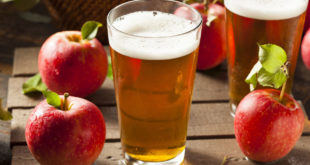The apples, after being plucked, are left in heaps in the orchard for some time, to complete their ripening, and render them more saccharine. They are then crushed between grooved cylinders, surmounted by a hopper, or in a circular trough, by two vertical edge-wheels of wood moved by a horse; after passing through which, they are received into large tubs or crocks, and are then called pomace. They are afterwards laid on the vat in alternate layers of the pomace and clean straw, called reeds. They are then pressed, a little water being occasionally added. The juice passes through a hair sieve, or similar strainer, and is received in a large vessel, whence it is run into casks or open vats, where everything held in mechanical suspension is deposited. The fermentation is often slow of being developed; though the juice be set in November or December, the working sometimes hardly commences till March. Till this time the cider is sweet; it now becomes pungent and vinuous, and is ready to be racked for use. If the fermentation continue, it is usual to rack it again into a clean cask that has been well sulphured out, and to leave behind the head and sediment; or two or three cans of cider are put into a clean cask, and a match of brimstone burned in it. It is then agitated, by which the fermentation of that quantity is completely stopped. The cask is then nearly filled, the fermentation of the whole is checked, the process of racking is repeated until it becomes so, and is continued from time to time till the cider is in a quiet state and fit for drinking.
 Pasteur Brewing Louis Pasteur – Science, Health, and Brewing
Pasteur Brewing Louis Pasteur – Science, Health, and Brewing 